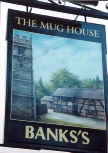


Publicans.
Public Beer Houses have existed since roman times and were regulated locally by the manorial officers. Several Inns were set up by the Church to provide Church goers with a wholesome drink. Small Beer was a popular drink consumed by both adults and children in the 16th and 17th centuries. It was of low alcohol content, and it was safer to drink than water because the alcohol killed harmful bacteria. The Mug House at Claines standing in the church yard still bears witness to this practice. Church drinking houses also provided refreshment for travellers on main thoroughfares. One such house was The Dog in Kidlington discussed later. The Alehouse Act 1552 (5 and 6 Edw.VI c.25) was the first attempt to co-ordinate existing controls and embody them in statute. Under this Act no-one was allowed to sell beer or ale without the consent of the local Justices of the Peace An act of 1729 gave formal approval to the practice of only granting licenses annually at special licensing sessions known as Brewster Sessions.
The Licensing Act of 1753 (26 Geo. II c.31) did not radically change existing legislation. New licenses could only be granted by persons producing certificates of good character usually signed by parish notables such as the Church Wardens and the constables elected by the Parish Council . Most importantly, however, the 1753 act ordered that full registers of victuallers and their recognizances were to be kept by the Clerk of the Peace at Quarter Sessions. Thus began a more thorough recording of the licensing business.
The Beer Act of 1830, enabled any householder of reputable character to obtain a beer house licence for a tenement or dwelling of rateable value, by merely paying the small sum of two guineas to the excise. This meant that more or less anybody who paid the poor rate could obtain a licence to sell beer without the necessity of having to apply to magistrates. This Act had a tremendous effect on licensed trade, effectively freeing trade in the sale of beer. Within a mere eight years, 46,000 beer houses were opened almost doubling the number of licensed premises. One such new inn or beerhouse was the Ibex in Chaddleworth which was converted from a farm house in 1838 and kept by Thomas MESSENGER [1308].
Although some old commercial Hotels existed on stage coach routes the vast majority of pubs were very simple cottages. Perhaps there would be a barrel or two of home brew flavoured with the berries from the chequers tree in the parlour of the licensee. There would be few, if any chairs, men would stand and talk while making their one pint a night allowance last as long as possible. Frederick Thomas McMULLIN told us that a gallon of beer cost 8d (1d a pint) when he was a young man about 1910 at a time when a labourer earned around 10 shilling a week. These Cottage Inns would hardly have supported a family and the censuses show that most publicans had another trade indeed they usually list the pub as the second occupation if at all.
These cottage pubs were known by the symbols or signs placed in front of the premises to alert people to the presence of the refreshment! The symbols used often reflected the publican's trade so an Agricultural labourer would place a plough outside and eventually the house would be known as The Plough. The Gunsmith’s Arms was run by the sons of the gunsmith Robert HEARD [2594]. The Sawyer’s Arms was conveniently near a sawpit but the landlord John FROUD [1666] was a shoemaker. Another shoemaker Thomas FROUD [1677] was at the well named Cripin. St Crispin is the Patron saint of shoe makers
Anstis FAULKNER [10087] must have come by an anchor as she kept The Anchor. After her death her son in law John WATTS [10049] and eventually her grandson continued at the same pub but then the family moved. The Anchor was renamed The Railway Hotel, as a line had been built close to the Inn. Our family took over another pub in the same town this was a well established pub known as The Dog but shortly after the family moved here it became known as The Dog and Anchor so presumably the Anchor had moved with them. Once Richard YOUNG [4665] left it reverted to its old name “The Dog”
Possibly Samuel THOMPSON [5865] and his wife are keeping a store by a stable for barge horses near the the moorings at Headingstone, Northampton in 1851 adding Beer to their other wares. William ALLEN [6396] and Edward BALE [237] may also have opened their homes as simple Beer Houses. William ALLEN was a tin plate worker, he was probably working on small items in a small unit rather than a factory and subsidising poor pay selling beer. Edward BALE is described as a farmer and ale house keeper when his son was baptised in 1814 and a victualler in 1818 at his daughter’s baptism.but this was well before the 1830 act. The name of these establishment have yet to be found.
Hotels and coaching Inns had signs long before the beer houses one of interest is the sign of the Red Lion. This is still one of the most popular pub names and is supposed to have come about when James VI of Scotland inherited the throne of England in 1603. In order to reinforce his authority to rule, James I of England decreed that all public buildings (which included taverns) must display in prominent places a heraldic red lion. We have several Red Lions.
As mentioned earlier many of the earliest pubs were associated with the church as already mentioned with the Mug House in Claines we also have the Jesus House in Kidlington being set up by monks on a pilgrim way. Early pubs often carried the sign of the Pope’s head but this was replaced when Henry VIII broke from the Church of Rome for a portrait of the King’s Head. You will find three King’s Heads on our list along with other inns with royalist sympathies. Much has been written about Inn signs and we will only mention them where they have particular significance to a family pub.
Over time some of our pubs like The Dog in Kidlington, have been converted back into family homes. Sadly along with many others some of our old pubs, including The Red Lion, Chipping Norton, have been pulled down during town renovations.
In the words of a song by Johnny Handle and popularised by The Spinners “They’re knockin’ ’em down. The old pubs. Around the town, The old pubs, ...”
Found illustrating a piece about The King’s Head Coleford,Somerset in a production by the Radford Museum Issue 31 of “The five Arches” magazine of the Radford Museum
A Trip Down Memory Lane in the company of Dick Price,
The original piece had an illustration of a group of men drinking with dogs at their feet
Rules of the Inne
No Thieves,Fakirs, Rogues or Tinkers~
No Skulking Loafers or
Flea- Bitten Tramps
No Slap an’ Tickle o’ the Wenches
No Banging o’ Tankards on the Tables
No dogs allowed in the kitchen
No Cockfighting
Flintlocks,Cudgels,
Daggers and Swords
To be handed to the innkeeper
For safekeeping ~ colliercollier___
________________________
Bed for the Night .... .... .... 1 Shilling
Stabling for Horse ... ... ... 4 pence
~~~1786~~~
An article appeared in the fortnightly magazine The Harmswoth Self Educator edited by Arthur Mee (Robson 2002 Every Man For Himself!) setting out the situation of licensed victuallers in 1906.
...no other trade is so encompassed and hedged about with laws, so subject to legal regulation in all its details, or so great an object of the attentions of social reformers and zealots. It was suggested that a landlord of “small capital” would be advised to take a tenancy with a good brewer in “a semi working class neighbourhood,where most of the houses are classed as “small property”....plenty of people walking about. Beer is the article mostly sold, for the English working man drinks little or no spirits. However the rent could be between £50-100 per year It appears that our Cornish publicans were tenants rather than owners.
The article explains how easy it was to loose the licence apart from keeping a disorderly house or serving drunken people, it was forbidden to serve children under 14 drink in open vessels, allowing betting and gaming or billiards to be played after hours, no betting slips to be passed on the premises and it was an offence if someone used the proceeds of a bet to purchase drinks. From this it would appear that children under 14 could be served sealed bottles in the pub and a 14 year old could have a glass of beer there.
Enjoy this pub crawl with our ancestors.
See our list of family publicans etc. page
Site layout and content © 2007-